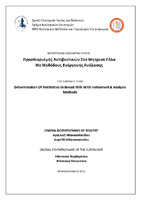| dc.contributor.advisor | VARVARESOU, ATHANASIA | |
| dc.contributor.author | Αθανασοπούλου, Αγγελική | |
| dc.date.accessioned | 2023-04-27T10:31:10Z | |
| dc.date.available | 2023-04-27T10:31:10Z | |
| dc.date.issued | 2023-04 | |
| dc.identifier.uri | https://polynoe.lib.uniwa.gr/xmlui/handle/11400/4272 | |
| dc.identifier.uri | http://dx.doi.org/10.26265/polynoe-4111 | |
| dc.description.abstract | Εισαγωγή: Ο θηλασμός προτείνεται ως η καλύτερη μορφή διατροφής για τα βρέφη, καθώς δεν είναι μόνο θρεπτική τροφή αλλά έχει και αντι-μολυσματικά οφέλη. Οι μητέρες που θηλάζουν είναι συχνό φαινόμενο να κάνουν χρήση αντιβιοτικών τα οποία έχει αναφερθεί στις έρευνες ότι περνούν από την μητέρα στο μητρικό γάλα. Είναι αποδεκτό και στον κτηνοτροφικό τομέα, αλλά και επιβεβαιώνεται και για τον άνθρωπο, ότι τα αντιβιοτικά που παίρνει η μητέρα μπορεί να επηρεάσουν αρνητικά την υγεία του βρέφους. Είναι δυνατό να γίνει, με τις κατάλληλες ενόργανες μεθόδους, προσδιορισμός των αντιβιοτικών στο μητρικό γάλα. Οι μητέρες θα επωφελούταν ιδιαίτερα από την χρήση γρήγορων και εύχρηστων τεστ που θα επιτρέψουν τον προσδιορισμό των αντιβιοτικών ακόμα και στο σπίτι.
Σκοπός: Σκοπός της εργασίας αυτής είναι να παρουσιάσει τις ενόργανες μεθόδους προσδιορισμού των αντιβιοτικών στο μητρικό γάλα μέσω της παρουσίασης πρόσφατων σχετικών ερευνών. Επιπλέον, σκοπός ήταν η αναζήτηση εύχρηστων κιτ για την χρήση αυτή.
Μέθοδος: Θα πραγματοποιηθεί βιβλιογραφική ανασκόπηση βιβλιογραφικών και εμπειρικών ερευνών, στις βάσεις δεδομένων PubMed, Google Scholar, ResearchGate.
Αποτελέσματα: Aπό τη μελέτη της βιβλιογραφίας προέκυψαν μεθοδολογίες ανοσοχρωματογραφικού προσδιορισμού, διαδικασίες εκχύλισης, μέθοδοι UPLC/MS-MS καθώς και ανοσοδοκιμασίες πλευρικής ροής με βάση το λατέξ (LFIA) αλλά και μεθοδολογίες εύχρηστων strip tests με βάση την ανοσοχρωματογραφία, για τον προσδιορισμό των αντιβιοτικών στο μητρικό γάλα.
Συμπεράσματα: Είναι πολύ σημαντική η ανίχνευση των αντιβιοτικών στο μητρικό γάλα προκειμένου να ελαχιστοποιηθεί η τυχόν αρνητική επίδραση τους στο βρέφος. Η ιατρική τεχνολογία έχει προχωρήσει τόσο ώστε με τις μεθόδους αυτές να έχει τα μέσα για τον προσδιορισμό των αντιβιοτικών στο μητρικό γάλα. Στην κτηνοτροφία χρησιμοποιούνται συχνά γρήγορα τεστ με βάση την ανοσοχρωματογραφία για τον σκοπό αυτό. Βρέθηκε στη βιβλιογραφία και μία υπό έγκριση δοκιμασία πλευρικής ροής που επιτρέπει την γρήγορη και στο σπίτι ανίχνευση αντιβιοτικών ουσιών στο ανθρώπινο μητρικό γάλα | el |
| dc.format.extent | 48 | el |
| dc.language.iso | el | el |
| dc.publisher | Πανεπιστήμιο Δυτικής Αττικής | el |
| dc.rights | Αναφορά Δημιουργού - Μη Εμπορική Χρήση - Παρόμοια Διανομή 4.0 Διεθνές | * |
| dc.rights | Αναφορά Δημιουργού 4.0 Διεθνές | * |
| dc.rights | Αναφορά Δημιουργού 4.0 Διεθνές | * |
| dc.rights.uri | http://creativecommons.org/licenses/by/4.0/ | * |
| dc.subject | Μητρικό γάλα | el |
| dc.subject | Αντιβιοτικά | el |
| dc.subject | Ενόργανη ανάλυση | el |
| dc.subject | Βρέφη | el |
| dc.subject | Θηλασμός | el |
| dc.title | Προσδιορισμός αντιβιοτικών στο μητρικό γάλα με μεθόδους ενόργανης ανάλυσης | el |
| dc.title.alternative | Determination of antibiotics in breast milk with instrumental analysis methods | el |
| dc.type | Μεταπτυχιακή διπλωματική εργασία | el |
| dc.contributor.committee | TSOTSOU, GEORGIA ELENI | |
| dc.contributor.faculty | Σχολή Επιστημών Υγείας & Πρόνοιας | el |
| dc.contributor.department | Τμήμα Βιοϊατρικών Επιστημών | el |
| dc.contributor.master | Βιοϊατρικές Μέθοδοι και Τεχνολογία στη Διάγνωση | el |
| dc.description.abstracttranslated | Introduction: Breastfeeding is suggested as the best form of nutrition for infants, as it is not only nutritious food but also has anti-infectious benefits. It is common for nursing mothers to use antibiotics, which have been reported in research to pass from the mother into breast milk. It is also accepted in the livestock sector, but also confirmed for humans, that antibiotics taken by the mother can negatively affect the health of the infant. It is possible, with appropriate instrumental methods, to determine the antibiotics in breast milk. Mothers would especially benefit from the use of quick and easy-to-use tests that would allow antibiotics to be determined even at home.
Purpose: The purpose of this work is to present the instrumental methods for the determination of antibiotics in breast milk through the presentation of recent relevant research. In addition, the aim was to search for easy-to-use kits for this use.
Method: A bibliographic review of literature and empirical research will be carried out in the databases PubMed, Google Scholar, ResearchGate.
Results: From the study of the literature, immunochromatographic determination methodologies, extraction procedures, UPLC/MS-MS methods as well as latex-based lateral flow immunoassays (LFIA) as well as methodologies of flexible strip tests based on immunochromatography emerged for the determination of antibiotics in breast milk.
Conclusions: It is very important to detect antibiotics in breast milk in order to minimize their possible negative effect on the infant. Medical technology has advanced so far that with these methods it has the means to determine antibiotics in breast milk. Rapid immunochromatography-based tests are often used in animal husbandry for this purpose. A licensed lateral flow assay was also found in the literature that allows for the rapid and at-home detection of antibiotic substances in human breast milk. | el |


